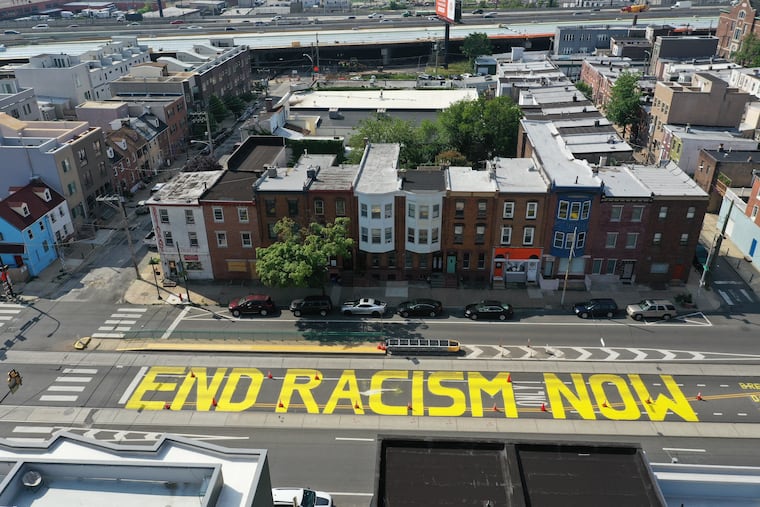Fishtown’s ‘End Racism Now’ street painting causes controversy a week after police, armed vigilantes clashed with peaceful protesters
The pastor who organized the event said he was hurt to hear people call him a “pawn” for inviting law enforcement to participate. As a minister, he said he believes engaging with police officers does more to facilitate healing than ostracizing them.

People knelt along Girard Avenue with paint brushes, writing “End Racism Now” in bold yellow letters on the Fishtown street. The scene played out Tuesday night just outside the 26th District police station, near where protesters and neighborhood men armed with bats faced off last week.
Like anti-racism street paintings in other cities, the images from Philadelphia quickly spread on social media.
Organizer the Rev. John T. Brice, pastor of Olney’s St. James United Methodist Church, called the event a “phenomenal" step toward community healing for residents and police officers.
Some residents, however, had a different take, saying the demonstration amplified “empty promises" and seemed like a public relations move by a police force that has yet to atone for its actions of last week.
» READ MORE: Philly police stood by as men with baseball bats ‘protected’ Fishtown. Some residents were assaulted and threatened.
Conrad Benner, a lifelong Fishtowner and founder of the blog StreetsDept.com, said Wednesday that he had heard from at least a dozen residents who expressed “an overwhelming frustration and disappointment in what yesterday’s event was supposed to be.”
He pointed to an online petition, started last week and signed by more than 33,000 people, that asks for the removal of the precinct’s Capt. William Fisher and an investigation of all officers involved in protecting and enabling the armed men who threatened residents amid protests.
“What folks are asking for is police accountability,” Benner said, “and what they got last night was an event where they were asked to applaud the police, and police were not asked any critical questions about their behavior last week.”
Hours after the painting, Philadelphia firefighters tried to wash the words from the street, at the request of the organizers, who didn’t have a permit for a permanent display. It was a scene critics interpreted as another example of superficiality.
But Wednesday morning, the words were still there.
A spokesperson for Mayor Jim Kenney said the city “has no intentions of removing it at this time." The Streets Department told Brice the mural can remain until it dissolves naturally.
When Troy Musto heard rumors that the message might have been washed away, he had to see for himself. Musto and his daughter, Stella, had helped paint it.
“I’m glad to see it’s still here,” he said, standing with Stella near the letters.
“We didn’t come out here to paint last night for any PR stunt, we came to support Black Lives Matter,” Musto said, adding that after a tumultuous week in the neighborhood, the Tuesday scene was “beautiful.”
Brice said he was hurt to hear some people call him a “pawn” for organizing and inviting law enforcement to participate. As a pastor, he said, he believes engaging with police officers does more to facilitate healing than ostracizing them.
The street painting was a grassroots effort, Brice said, that he and several other community members began planning Monday.
While Brice would have loved for the words to be forever etched in Fishtown, he said it would have taken more time for the city to approve a permit. Organizers didn’t want to wait, he said, and lose the momentum of the peaceful anti-racism protests sparked by the death of George Floyd, an unarmed black man who was killed when a white Minneapolis police officer knelt on his neck for nearly nine minutes.
Brice said he reached out to the 26th District about 5 p.m. Tuesday, shortly before the event began. He told police that the community was hurting, he said, and that he wanted to push for change.
As a few hundred people painted the message — as well as the names Donta Dawson and David Jones, two local victims of police brutality — police stood nearby, Brice said.
At one point, Brice said, he approached Fisher and asked him “to be a part of the healing.” Fisher then helped paint Floyd’s name.
“Matthew 5:9 calls me to be a peacemaker, not a peacekeeper,” the pastor said. “I have to be intentional."
Brice said he understands residents’ anger and hurt, but doesn’t think pushing out the captain or other officers is the solution.
“Allowing Capt. Fisher to learn, to apologize, to take intentional steps … is what changes the heart of the community,” he said.
Josh Miller, 27, of Northeast Philadelphia, said he showed up to Tuesday’s event after seeing the impact that Washington residents had after they wrote “Black Lives Matter” on Pennsylvania Avenue. When police were given a platform to speak in Fishtown, Miller said, he had to walk away.
“I didn’t go there to hear police say ‘We’re going to work with the community’ and other empty promises," Miller said
Benner, 35, said many community members wish they could have been able to voice concerns to police at Tuesday’s event.
“This whole movement is about police accountability, and that precinct has yet to take accountability for anything they did last Monday,” he said. Until that happens, “no healing can begin.”